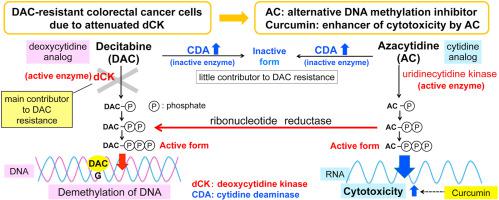Biochemical and Biophysical Research Communications ( IF 2.5 ) Pub Date : 2021-09-22 , DOI: 10.1016/j.bbrc.2021.09.041 Mika Hosokawa 1 , Risako Seiki 1 , Seigo Iwakawa 1 , Ken-Ichi Ogawara 1

|
Decitabine (DAC), a DNA methyltransferase (DNMT) inhibitor is a novel anti-cancer drug regulating epigenetic mechanisms. Similar to conventional anti-cancer drugs, drug resistance to DAC also has been reported, resulting in tumor recurrence. Our previous study using colorectal cancer HCT116 cells found the decrease in deoxycytidine kinase (dCK) (activation enzyme of DAC) and the increase in cytidine deaminase (inactivation enzyme of DAC) in acquired DAC-resistant HCT116 (HCT116/DAC) cells. The aim of our study was to clarify the involvement of dCK and CDA in DAC resistance. In order to tackle DAC resistance, it was also examined whether other DNMT inhibitors such as azacytidine (AC) and polyphenols are effective in DAC-resistant cancer cells. When dCK siRNA was transfected into HCT116 cells, IC50 value of DAC increased by about 74-fold and reached that of HCT116/DAC cells with attenuated dCK. dCK siRNA to HCT116 cells also abolished DNA demethylation effects of DAC. In contrast, CDA siRNA to HCT116 cells did not influence the efficacy of DAC. In addition, CDA siRNA to HCT116/DAC cells with increased CDA did not restore the compromised effects of DAC. These results suggested that attenuated dCK but not increased CDA mainly contributed to DAC resistance. Regarding dCK in HCT116/DAC cells, a point mutation with amino acid substitution was observed while the product size and expression of mRNA coding region did not change, suggesting that dCK protein was decreased by post-transcriptional regulation. AC and polyphenols showed no cross-resistance in HCT116/DAC cells. AC but not polyphenols exerted DNA demethylation effect. Among polyphenols, curcumin (Cur) showed the most synergistic cytotoxicity in combination with AC while DNA demethylation effect of AC was partly maintained. Taken together, combination of AC and Cur would be a promising alternative to tackle DAC resistance mainly due to attenuated dCK.
中文翻译:

氮杂胞苷和姜黄素的组合是具有减毒脱氧胞苷激酶的地西他滨耐药结直肠癌细胞的潜在替代方案
地西他滨 (DAC) 是一种 DNA 甲基转移酶 (DNMT) 抑制剂,是一种调节表观遗传机制的新型抗癌药物。与传统的抗癌药物类似,也有报道对 DAC 产生耐药性,导致肿瘤复发。我们之前使用结肠直肠癌 HCT116 细胞的研究发现,在获得性 DAC 抗性 HCT116 (HCT116/DAC) 细胞中,脱氧胞苷激酶 (dCK) (DAC 的活化酶) 减少和胞苷脱氨酶 (DAC 的失活酶) 增加。我们研究的目的是阐明 dCK 和 CDA 在 DAC 抗性中的作用。为了解决 DAC 耐药性,还检查了其他 DNMT 抑制剂如氮胞苷 (AC) 和多酚是否对 DAC 耐药性癌细胞有效。当 dCK siRNA 转染到 HCT116 细胞中时,IC 50DAC 的值增加了约 74 倍,达到了具有减毒 dCK 的 HCT116/DAC 细胞的值。HCT116 细胞的 dCK siRNA 也消除了 DAC 的 DNA 去甲基化作用。相反,针对 HCT116 细胞的 CDA siRNA 不影响 DAC 的功效。此外,CDA 增加的 HCT116/DAC 细胞的 CDA siRNA 并未恢复 DAC 受损的作用。这些结果表明,减弱的 dCK 而不是增加的 CDA 主要促成了 DAC 抗性。HCT116/DAC细胞中dCK发生点突变,有氨基酸取代,mRNA编码区产物大小和表达没有变化,提示dCK蛋白通过转录后调控降低。AC 和多酚在 HCT116/DAC 细胞中没有显示出交叉抗性。AC而不是多酚发挥DNA去甲基化作用。在多酚中,姜黄素 (Cur) 与 AC 组合显示出最协同的细胞毒性,而 AC 的 DNA 去甲基化作用得以部分维持。总之,AC 和 Cur 的组合将是解决 DAC 阻力的有希望的替代方案,主要是由于 dCK 衰减。











































 京公网安备 11010802027423号
京公网安备 11010802027423号